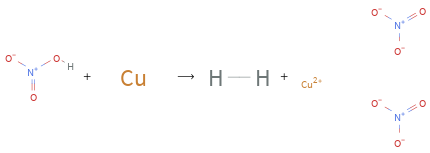Input interpretation

nitric acid + copper ⟶ hydrogen + copper(II) nitrate
Balanced equation

Balance the chemical equation algebraically: + ⟶ + Add stoichiometric coefficients, c_i, to the reactants and products: c_1 + c_2 ⟶ c_3 + c_4 Set the number of atoms in the reactants equal to the number of atoms in the products for H, N, O and Cu: H: | c_1 = 2 c_3 N: | c_1 = 2 c_4 O: | 3 c_1 = 6 c_4 Cu: | c_2 = c_4 Since the coefficients are relative quantities and underdetermined, choose a coefficient to set arbitrarily. To keep the coefficients small, the arbitrary value is ordinarily one. For instance, set c_2 = 1 and solve the system of equations for the remaining coefficients: c_1 = 2 c_2 = 1 c_3 = 1 c_4 = 1 Substitute the coefficients into the chemical reaction to obtain the balanced equation: Answer: | | 2 + ⟶ +
Structures

+ ⟶ +
Names

nitric acid + copper ⟶ hydrogen + copper(II) nitrate
Equilibrium constant
![K_c = ([H2] [Cu(NO3)2])/([HNO3]^2 [Cu])](../image_source/bf3598908f99b6d939e7c4c77d9a0e27.png)
K_c = ([H2] [Cu(NO3)2])/([HNO3]^2 [Cu])
Rate of reaction
![rate = -1/2 (Δ[HNO3])/(Δt) = -(Δ[Cu])/(Δt) = (Δ[H2])/(Δt) = (Δ[Cu(NO3)2])/(Δt) (assuming constant volume and no accumulation of intermediates or side products)](../image_source/cf3e3c717b80cc4c8f8c497fc8c27c74.png)
rate = -1/2 (Δ[HNO3])/(Δt) = -(Δ[Cu])/(Δt) = (Δ[H2])/(Δt) = (Δ[Cu(NO3)2])/(Δt) (assuming constant volume and no accumulation of intermediates or side products)
Chemical names and formulas

| nitric acid | copper | hydrogen | copper(II) nitrate Hill formula | HNO_3 | Cu | H_2 | CuN_2O_6 name | nitric acid | copper | hydrogen | copper(II) nitrate IUPAC name | nitric acid | copper | molecular hydrogen | copper(II) nitrate
Substance properties

| nitric acid | copper | hydrogen | copper(II) nitrate molar mass | 63.012 g/mol | 63.546 g/mol | 2.016 g/mol | 187.55 g/mol phase | liquid (at STP) | solid (at STP) | gas (at STP) | melting point | -41.6 °C | 1083 °C | -259.2 °C | boiling point | 83 °C | 2567 °C | -252.8 °C | density | 1.5129 g/cm^3 | 8.96 g/cm^3 | 8.99×10^-5 g/cm^3 (at 0 °C) | solubility in water | miscible | insoluble | | dynamic viscosity | 7.6×10^-4 Pa s (at 25 °C) | | 8.9×10^-6 Pa s (at 25 °C) | odor | | odorless | odorless |
Units
